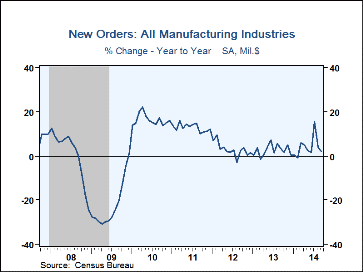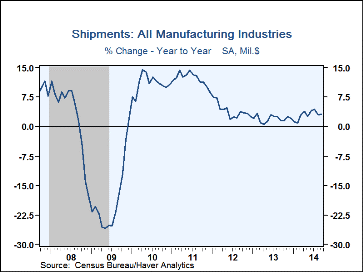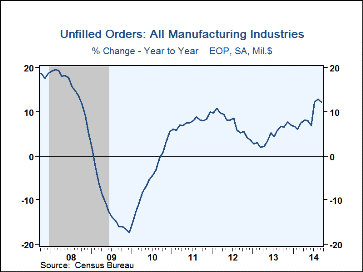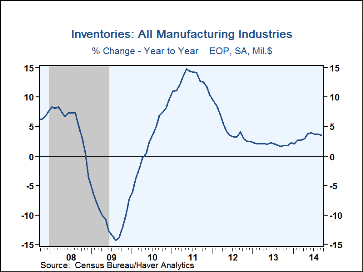 Global| Nov 04 2014
Global| Nov 04 2014U.S. Factory Sector Orders Decline With Fewer Aircraft
by:Tom Moeller
|in:Economy in Brief
Summary
New orders to all manufacturers fell 0.6% (+1.9% y/y) during September following the 10.0% August retrenchment. A 0.5% decline was expected in the Action Economics Forecast Survey. A 1.1% shortfall (+3.5% y/y) in durable goods orders [...]
New orders to all manufacturers fell 0.6% (+1.9% y/y) during September following the 10.0% August retrenchment. A 0.5% decline was expected in the Action Economics Forecast Survey. A 1.1% shortfall (+3.5% y/y) in durable goods orders led the drop and it was generated by a 16.1% decline (-19.2% y/y) in nondefense aircraft & parts orders. That followed the 74.0% drop during July. Factory sector orders excluding transportation equipment were roughly unchanged (+3.2% y/y), the same as in August. Orders for nondurable goods (which equal shipments) held steady (0.5% y/y) after a 0.4% drop. Shipments of apparel jumped 4.1% (6.7% y/y and textile mill shipments improved 0.8% (0.3% y/y). Petroleum shipments were off 0.1% (-3.9% y/y) but basic chemical shipments nudged up 0.1% (-0.6% y/y). Food product shipments fell 0.2% (+5.9% y/y).
Unfilled orders increased 0.3% (12.2% y/y) while order backlogs excluding the transportation sector rose 0.7% (6.8% y/y). Electrical equipment backlogs rose 2.1% (13.5% y/y) and unfilled orders for computers & electronic products gained 0.7% (6.8% y/y). Unfilled orders of machinery increased 0.1% (11.8% y/y) while furniture backlogs improved 1.3% (7.4% y/y).
Inventories in the factory sector rose 0.2% (3.5% y/y). In the durable goods sector, inventories rose 0.4% (5.8% y/y) for the fourth straight month. Primary metals inventories gained 0.6% (6.1% y/y) but electrical equipment inventories retreated 1.0% (-0.7% y/y). Amongst nondurable goods industries, inventories were roughly unchanged (0.1% y/y). Petroleum inventories dropped 1.0% (-4.6% y/y), basic chemicals edged up 0.2% (0.1% y/y) while apparel inventories rose 0.7% (24.5% y/y).
Housing Market Headwinds from the Federal Reserve Bank of San Francisco is available here.
The factory sector figures are available in Haver's USECON database.
| Factory Sector- NAICS Classification (%) | Sep | Aug | Jul | Y/Y | 2013 | 2012 | 2011 |
|---|---|---|---|---|---|---|---|
| New Orders | -0.6 | -10.0 | 10.5 | 1.9 | 2.7 | 2.9 | 12.9 |
| Shipments | 0.1 | -1.1 | 1.4 | 3.1 | 2.0 | 4.0 | 12.1 |
| Inventories | 0.2 | 0.1 | 0.0 | 3.5 | 2.3 | 2.4 | 10.2 |
| Unfilled Orders | 0.3 | 0.6 | 5.3 | 12.2 | 7.0 | 3.7 | 10.0 |
Tom Moeller
AuthorMore in Author Profile »Prior to joining Haver Analytics in 2000, Mr. Moeller worked as the Economist at Chancellor Capital Management from 1985 to 1999. There, he developed comprehensive economic forecasts and interpreted economic data for equity and fixed income portfolio managers. Also at Chancellor, Mr. Moeller worked as an equity analyst and was responsible for researching and rating companies in the economically sensitive automobile and housing industries for investment in Chancellor’s equity portfolio. Prior to joining Chancellor, Mr. Moeller was an Economist at Citibank from 1979 to 1984. He also analyzed pricing behavior in the metals industry for the Council on Wage and Price Stability in Washington, D.C. In 1999, Mr. Moeller received the award for most accurate forecast from the Forecasters' Club of New York. From 1990 to 1992 he was President of the New York Association for Business Economists. Mr. Moeller earned an M.B.A. in Finance from Fordham University, where he graduated in 1987. He holds a Bachelor of Arts in Economics from George Washington University.










